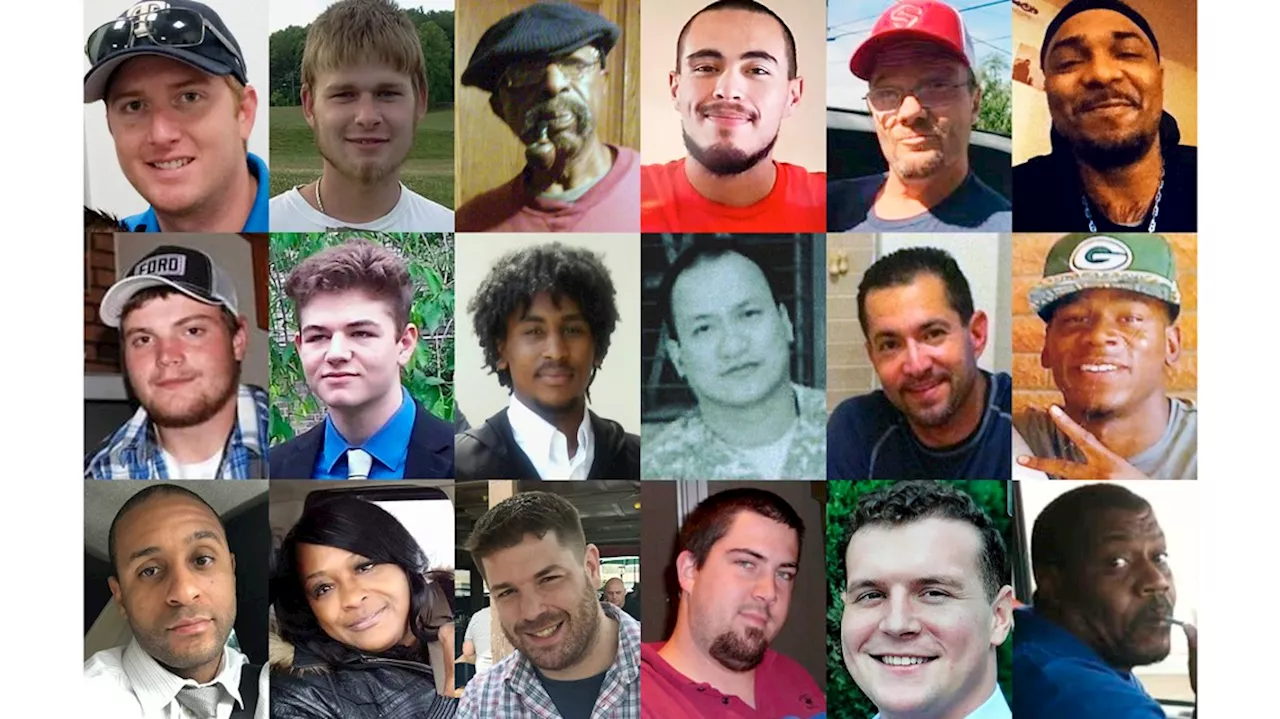The family is suing St. Louis County and the detective who ordered the raid.
In hundreds of cases, officers weren’t taught or didn’t follow best safety practices for physical force and weapons, creating a recipe for death.WASHINGTON — Carl Grant, a Vietnam veteran with dementia, wandered out of a hospital room to charge a cellphone he imagined he had. When he wouldn’t sit still, the Taylor Ware, a former Marine and aspiring college student, walked the grassy grounds of an interstate rest stop trying to shake the voices in his head.
“We were robbed,” said Carl Grant’s sister, Kathy Jenkins, whose anger has not subsided four years later. “It’s like somebody went in your house and just took something, and you were violated.” The federal government has struggled for years to count deaths following what police call “less-lethal force,” and the little information it collects is often kept from the public and highly incomplete at best. No more than a third of the cases the AP identified are listed in federal mortality data as involving law enforcement at all.
In hundreds of cases, officers repeated errors that experts and trainers have spent years trying to eliminate — perhaps none more prevalent than how they held someone facedown in what is known as prone restraint. One of the last hopes for accountability from inside the system — what are known as death opinions — also often exonerated officers. The medical examiners and coroners who decide on these did not link hundreds of the deaths to force, but instead to accidents, drug use or preexisting health problems, sometimes relying on debunked science or incomplete studies from sources tied to law enforcement.
“The only way to get down to zero is to get rid of policing,” Moskos said, “and that’s not going to save lives either.” At a second house about a half-mile away, police found him sitting in a porch chair. When he didn’t follow an order to get off the porch, a different officer pushed him down the stairs, according to previously unreleased body-camera video. Grant gashed his forehead in the fall.
“He’s almost 70 and confused,” Grant’s partner, Ronda Hernandez, said. “That’s what I don’t get. You just don’t do that to old people.” The disproportionate representation of Black people tracks research findings that they face higher rates and severity of force, and even deaths. The Department of Justice has found after multiple investigations that Black people accounted for more unjustified stops for minor offenses, illegal searches that produced no contraband, unnecessary force, or arrests without probable cause.
When an officer touched Ivy to detain him — a known trigger for some with severe mental illness — police say Ivy began to resist. An officer fired a Taser, then Ivy fled. Officers caught up and beat him with batons, shocked him several more times with a Taser, put him facedown and got on top of him. By the time they rolled Ivy over, he’d stopped breathing.
The United States has no national rules for how exactly to apply force. Instead, Supreme Court decisions set broad guard rails that weigh force as either “objectively reasonable” or “excessive,” based in part on the severity of the situation, any immediate safety threat and active resistance. The officer, an unpaid reserve marshal, assured Ware’s mother he’d had calls like this before. As she and a family friend watched, he stopped about 10 feet in front of Ware, according to video filmed by the friend and obtained by AP. His police dog barked and lunged several times — a provocation officers are told to avoid with the emotionally distressed. Ware remained seated.
A coroner ruled Ware’s death was due to natural causes, specifically “excited delirium” — a term for a condition that police say causes potentially life-threatening agitation, rapid heart rate and other symptoms. Major medical groups oppose it as a diagnosis, however, and say it is frequently an attempt to justify excessive force.
As with Ware, officers resorted to force in roughly 25% of the cases even though the circumstances weren’t imminently dangerous. Many began as routine calls that other officers have, time and again, resolved safely. Those included medical emergencies phoned in by families, friends or the person who died.
When done properly, placing someone on their stomach or shocking them is not inherently life-threatening. But there are risks: Prone restraint can compress the lungs and put stress on the heart, and Taser’s maker has issued warnings against repeated shocks or targeting the body near the heart. These risks intensify when safety protocols aren’t followed or when people with mental illness, the elderly or those on stimulant drugs are involved.
In dozens of police or witness videos, those who died began to fade on screen, their breathing becoming shallow, as happened in suburban San Diego to 56-year-old Oral Nunis. As part of the family’s lawsuit, two pathologists concluded that the restraint officers used led to his death. One officer was asked under oath if pressure on someone’s back could impair breathing. “I have had several bodies on top of me during different training scenarios,” the 6-foot, 265-pound officer said, “and I never had difficulty breathing.”
There was a Kansas man who used his elderly mother as a shield when deputies arrived. And there was a 41-year-old concrete mason in Minnesota who choked and punched his adult daughter before grabbing an officer by the throat and pushing her into a window.Rather than fire their pistols that night in 2018, two of the officers used their Tasers and managed to handcuff Stelzer, 25, as he thrashed on the floor. Stelzer stopped breathing, and the officers could not revive him.
Mortality data maintained by the Centers for Disease Control and Prevention also has gaps. The AP found that when a death certificate does not list words like “police” and “law enforcement,” the CDC’s language-reading software doesn’t label the death as involving “legal intervention.” This means the death data flagged police involvement in, at most, 34% of the more than 1,000 deaths the investigation identified.
“This is a long-standing, not-very-secret secret about the problem here: We know very little,” said Georgetown University law professor Christy Lopez, who until 2017 led the Justice Department office that investigates law enforcement agencies over excessive force.
United States Latest News, United States Headlines
Similar News:You can also read news stories similar to this one that we have collected from other news sources.
 Queen Camilla Calls Her Grandson Louis a 'Handful,' But She Didn't Mean Prince LouisQueen Camilla made a comment about the name Louis during a visit to the Isle of Man, but Buckingham Palace said she didn't mean Prince Louis.
Queen Camilla Calls Her Grandson Louis a 'Handful,' But She Didn't Mean Prince LouisQueen Camilla made a comment about the name Louis during a visit to the Isle of Man, but Buckingham Palace said she didn't mean Prince Louis.
Read more »
 Ghostbusters: Frozen Empire Director Explains Why Rick Moranis' Louis Tully Didn't ReturnDirector Gil Kenan explains the reason behind Rick Moranis' Louis Tully not making a return in Ghostbusters: Frozen Empire and expresses his desire to bring back Sigourney Weaver's Dana Barrett in future sequels.
Ghostbusters: Frozen Empire Director Explains Why Rick Moranis' Louis Tully Didn't ReturnDirector Gil Kenan explains the reason behind Rick Moranis' Louis Tully not making a return in Ghostbusters: Frozen Empire and expresses his desire to bring back Sigourney Weaver's Dana Barrett in future sequels.
Read more »
 Why is Japan changing its ban on exporting lethal weapons, and why is it so controversial?Japan’s Cabinet OK’d a plan to sell future next-generation fighter jets to other countries on Tuesday, its latest step away from the pacifist principles the country adopted at the end of World War II
Why is Japan changing its ban on exporting lethal weapons, and why is it so controversial?Japan’s Cabinet OK’d a plan to sell future next-generation fighter jets to other countries on Tuesday, its latest step away from the pacifist principles the country adopted at the end of World War II
Read more »
 Why is Japan changing its ban on exporting lethal weapons, and why is it so controversial?Japan’s Cabinet OK’d a plan to sell future next-generation fighter jets to other countries on Tuesday, its latest step away from the pacifist principles the country adopted at the end of World War II.
Why is Japan changing its ban on exporting lethal weapons, and why is it so controversial?Japan’s Cabinet OK’d a plan to sell future next-generation fighter jets to other countries on Tuesday, its latest step away from the pacifist principles the country adopted at the end of World War II.
Read more »
 Why is Japan changing its ban on exporting lethal weapons, and why is it so controversial?Japan’s Cabinet OK’d a plan to sell future next-generation fighter jets to other countries on Tuesday, its latest step away from the pacifist principles the country adopted at the end of World War II.
Why is Japan changing its ban on exporting lethal weapons, and why is it so controversial?Japan’s Cabinet OK’d a plan to sell future next-generation fighter jets to other countries on Tuesday, its latest step away from the pacifist principles the country adopted at the end of World War II.
Read more »
 Why is Japan changing its ban on exporting lethal weapons, and why is it so controversial?Japan’s Cabinet OK’d a plan to sell future next-generation fighter jets to other countries on Tuesday, its latest step away from the pacifist principles the country adopted at the end of World War II.
Why is Japan changing its ban on exporting lethal weapons, and why is it so controversial?Japan’s Cabinet OK’d a plan to sell future next-generation fighter jets to other countries on Tuesday, its latest step away from the pacifist principles the country adopted at the end of World War II.
Read more »
